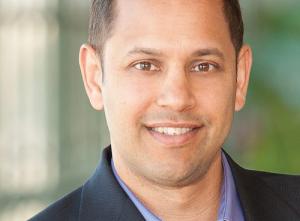For Your Consideration
Joe Song leads the Project Operations group at Sol Systems, the team responsible for engineering, development, and construction management for all development and M&A projects. Under his leadership, Sol Systems has built the capabilities to deliver over 500 MW of operational solar assets across 12+ U.S. markets. Joe Song holds a B.S. in mechanical engineering from California Polytechnic State University.
Sachu Constantine leads the Vote Solar Regulatory Team, coordinating strategy and operations for a team of experts engaging in regulatory and policy proceedings across the country. Vote Solar is active in more than 20 dockets across the country. Mr. Constantine has an MPP from the Goldman School of Public Policy, University of California, Berkeley.
A tree that is unbending is easily broken

- Lao Tzu
Science proves the link between expanding carbon emissions and climate change, the impacts of which are accelerating and lasting. Since April 2017, the Atlantic basin has generated thirty-two named storms - sixty percent above average - including some of the most powerful and destructive storms ever recorded.
In 2018 alone, two major hurricanes, Florence and Michael, caused billions of dollars of damage and stranded millions of customers without power along the eastern seaboard. In the Western United States, wildfires intensified by climate change consumed homes and lives, leading to utility bankruptcies as well as service disruptions. The message is clear that we have to reduce our carbon footprint dramatically, but even if we do, we are in for a rough ride for some time to come.
 Joe Song: Distributed solar inverters can wake-up and be operational within five minutes of detecting grid voltage then automatically synchronize with the grid.
Joe Song: Distributed solar inverters can wake-up and be operational within five minutes of detecting grid voltage then automatically synchronize with the grid.
Our aging fossil-fuel-based energy system, including transmission and distribution lines and power plants, is becoming increasingly vulnerable in an age of global warming, while contributing to that warming itself.
Decarbonizing the electric system through the increased use of fossil-free resources like solar is essential, but even after squeezing fossil energy out of the system, the grid itself will still be at risk of failure for many decades to come. What can we do to make our communities more resilient to both climate change and grid disruptions?
One approach is to harden the grid, making it more resistant to damage from weather and climate-related events. Grid hardening could include undergrounding of distribution wires and equipment, replacing wooden poles with metal ones, reconductoring with insulated wires (uninsulated wires may have sparked several of the recent fires in California) and installing additional protective gear.
Grid hardening could also include increased maintenance of existing infrastructure, like tree clearing, reinforcing riser poles, and having readily available spare equipment for critical components.
 Sachu Constantine: As a fleet of power plants, solar can lighten the load on the transmission and distribution system and limit the impacts of disruptions to the grid.
Sachu Constantine: As a fleet of power plants, solar can lighten the load on the transmission and distribution system and limit the impacts of disruptions to the grid.
In many cases, these are prudent investments and in line with the traditional expectation that utilities provide safe and reliable service. But nature always bats last. Can we build a power grid that can withstand all the big hits we expect to see? Probably not, at least at reasonable costs.
Community Resiliency
It would be prudent, then, to think about the broader concept of community resiliency. Resilience in nature, as described by the Canadian ecologist C.S. Holling, is the ability of an ecosystem to absorb damage and continue to function and provide vital life support as before, but with reorganized parts.
For an engineered system like the electric grid, resilience means organizing a smarter, more flexible power system, able to operate in a variety of configurations and with the ability to self-heal and recover quickly from major disruptions.
We need more solar and renewables for multiple reasons, including cost, national security, and to reduce our carbon footprint in the face of potentially catastrophic anthropogenic climate change. But modern, distributed, solar-powered electric systems can also operate in a more flexible manner.
Solar, energy storage and energy efficiency can provide a full spectrum of energy services. In fact, inverter-based technologies are often faster than conventional fossil resources at responding to grid operational needs.
Solar plants can operate in grid-connected mode, as part of a micro-grid (islanded) or as stand-alone systems and can be built in a range of scales from rooftop systems to megawatt-scale solar farms.
Solar arrays are designed to continue operating, even in the event of a single inverter failure in the system. Distributed solar inverters can wake-up and be operational within five minutes of detecting grid voltage then automatically synchronize with the grid.
These traits and others make solar, along with energy storage and other distributed energy resources, an exceptionally good fit for a modern, reliable, and flexible grid. What's more, they can build resilience that enables communities to hold together, even during major disruptions to the electricity grid.
Let's look at how commercial solar performed in response to Hurricanes Florence and Michael. First of all, unlike some of the nuclear assets in the region, there was no safety reason or call for solar to curtail generation as the storms bore down on the coast. Once the storms hit, solar systems appear to have held up robustly.
Out of the nearly one million panels Sol Systems deployed in the region, less than a hundred panels were damaged by Florence. That's a hundred and ninety-seven megawatts of capacity spread across multiple locations, mostly ready to go online right after the storm.
Sol Systems' power plants are monitored in real time so operators can track system status by the second. In one case, a tree fell directly on a facility, but ninety-five percent of the site was available to go back online. In fact, of its nine operating sites that were impacted, six of Sol Systems' power plants were back online and providing power within forty-eight hours.
The vast majority of Sol Systems' facilities were ready to go well before power was eventually restored to the millions of customers affected by outages but were prevented from coming back online because of damage elsewhere in the system, including flooded substations and downed power lines. The inclusion of advanced inverters would enable the formation of stable micro-grids capable of synchronizing with other power technologies and load.
Barring destruction of the underlying building, most rooftop systems were also ready to go, but they are only set up to operate in grid-connected mode when the larger electric system is fully restored. This means that potential generation, close to the electricity demand of people who need it, was left idle while the larger system was being repaired.
Of course, to take advantage of this inherent resiliency, grid architecture and controls have to be rethought. Utility-, community-, and behind-the-meter-scale solar facilities can all play a role in building resilience.
Vote Solar estimates that a minimum of two thousand gigawatts of solar capacity can be deployed by 2050 with a robust mix of distributed facilities. Between now and 2030, a fifty- to eighty-fold increase (up to eighty-four gigawatts) in the deployment of community scale solar is achievable and would bring multiple economic, environmental, health and social benefits along with it.
Complementing commercial systems, rooftop and community solar installations are geographically diverse and will be located close to load. That proximity comes with a whole host of benefits, including more efficient delivery of electricity, increased power factor and quality of power, and reduced grid losses.
In addition, community solar can be strategically sited on the distribution grid and co-located with other DERs to maximize community resiliency. As a fleet of power plants, solar can lighten the load on the transmission and distribution system and limit the impacts of disruptions to the grid. Policies that create barriers or undervalue solar undermine the opportunity to create more resilient communities.
More microgrids, switches, and sensors would allow resources to be turned on and used as they were available, rather than after some larger system restoration threshold is passed. These advanced technologies would also serve to facilitate a smarter relationship with the larger grid. In fact, some parts of the system may never have gone down in the first place. The grid should be operated as a network of nested subsystems coordinating on a variety of scales.
While grid hardening investments play an important role, utility planners and regulators should strike a careful balance. Resilience is not something we drop on top of the grid like a coat of armor; it requires careful design, rising up from the current architecture of the grid.
The characteristics of modern solar systems, paired with storage and other DERs, can make for a robust electric system more resistant to external disruption, from central dispatch to grid edge.
Increased operational flexibility should be a high priority as well, and regulators and planners must recognize the role that distributed solar can play in providing grid operators with more options to manage perturbations on the grid.
In California, opportunities to de-energize transmission and distribution lines need to be exercised to prevent wildfires like the one that destroyed the city of Paradise. A smart, modern, and flexible grid capable of providing reliable, high-quality power from both local and central station resources will make future decisions to de-energize portions of the grid easier, even commonplace.
Grid Modernization
Grid modernization has emerged as a term applied to many different kinds of investments in our aging transmission and distribution infrastructure. Utility regulators must decide which investments will most effectively address the pressing need to slow further climate change by reducing carbon emissions economy-wide and protect communities from extreme weather and electricity demand (such as for air conditioning, water pumping and treatment, etc.) precipitated by the warming that has already occurred.
States like California, New York, and Hawaii have regulatory proceedings underway that can serve as catalysts for the kinds of change needed. California, for example, defines grid modernization as allowing "for the integration of DERs while maintaining and improving safety and reliability."
Last year, the Solar Energy Industries Association articulated important actions required for effective grid modernization, including updates to utility system planning and transparency, including determination of hosting capacity for clean energy resources, and faster, inexpensive interconnection.
SEIA also recommending establishing a robust benefit-cost framework that reflects both temporal and locational values; identify alternatives to traditional utility investments, including leveraging the capabilities of smart inverters, distributed solar+storage systems and other DERs; modifying value/compensation frameworks and avoiding arbitrary or punitive charges on customer-sited facilities; and updating the operation of the grid itself, through improved telemetry and control systems (switches, sensors, smart meters and software).
Vote Solar advocates for policies that support a more modern, reliable, flexible grid that takes advantage of solar and DER technology on both sides of the meter as integral parts of the system. In short, we need a clean and inherently resilient energy system.
Across the country, many forward-thinking utilities are engaging in integrated resource planning that does just that. NV Energy, NIPSCO, Consumers Energy, PacifiCorp, and Xcel, among others, have all announced varying degrees of decarbonization and decentralization in their plans. But the efforts are still sporadic and inconsistent.
Looking Ahead
In order to achieve a more comprehensive, nationwide approach, Vote Solar makes a number of recommendations to regulators: require IRPs for all load-serving entities in their jurisdictions and assure coordination among LSEs to encourage the development and use of shared resources; authorize and support studies to support the development and use of DERs for grid modernization and resilience; and adopt new rate designs to incentivize smarter use of energy and correctly value the use of DERs and non-wires alternatives (NWAs), reducing the need to build new grid infrastructure;
Vote Solar also recommends to: establish pilot projects to demonstrate DERs' use as NWAs and establish processes to identify future opportunities for NWAs, including storage to reduce the reliance on fossil-fired spinning reserves; explore new rate regulation models that value services or performance metrics over capital investments; facilitate stakeholder processes for grid transformation; and update benefit-cost analysis methodologies to properly account for DER capacities and falling costs;
Finally, Vote Solar recommends to: streamline DER interconnection by reducing transaction costs and create publicly available maps and information about the distribution system, identifying where DERs provide the highest value; create opportunities for DER customers and aggregators to participate in markets for ancillary services; enable sustainable and scalable community solar projects; and revise rules related to islanded operation and microgrids that reflect new technologies and safety concerns.
There is no dispute over the need to invest in making the grid more resistant to hurricanes, wildfires and other catastrophic events. Indeed, this responsibility is a fundamental part of the regulatory compact to provide safe, reliable service.
Equally important will be investments in smart grid technologies, distribution resource planning and sophisticated tariffs that enhance community resilience. Solar has a vital role to play in making communities more resilient and leading the transformation to a clean energy future.



